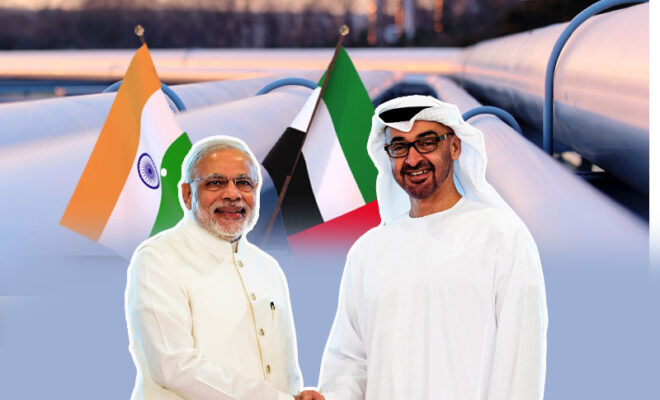India-UAE Undersea Gas Pipeline Project To Connect 2,000 KM Energy Corridor

The proposed undersea UAE-Gujarat gas pipeline provides a solid foundation for transforming the energy landscape between India & the Middle East.
The energy sector plays a critical role in the economic growth of nations, and the proposed undersea UAE-Gujarat gas pipeline is set to revolutionize the energy landscape.
With an estimated cost of $5 billion, this ambitious project aims to connect the Middle East and India through a 2,000-kilometer-long energy corridor.
With substantial gas reserves, increasing demand, and the potential for significant savings, the project has attracted widespread attention.
Collaborative efforts between governments, stakeholders, and industry experts are crucial to translating this ambitious vision into a reality, providing a solid foundation for regional energy cooperation.
Its successful implementation could result in significant annual savings and propel the development of India’s energy infrastructure.
The Proposed Undersea UAE-Gujarat Gas Pipeline
The South Asia Gas Enterprise (SAGE), an international consortium specializing in deepwater pipeline projects, is the driving force behind the undersea UAE-Gujarat gas pipeline.
This groundbreaking initiative has caught the attention of industry experts and government bodies alike. The project’s main objective is to establish a reliable and cost-effective means of transporting natural gas from the Gulf to India.
The Importance of the Project
The undersea UAE-Gujarat gas pipeline has the potential to generate substantial benefits for both India and the Middle East.
By tapping into the region’s abundant natural gas reserves, the project could save an estimated `7,000 crore annually compared to importing liquefied natural gas (LNG) in the same quantity.
Furthermore, it presents an opportunity to diversify India’s energy sources, reduce dependence on traditional imports, and promote energy security.
Feasibility Study and Stakeholder Support
SAGE has diligently conducted a comprehensive feasibility study of the project, considering both technical and financial aspects.
The results have been encouraging, garnering positive responses from various stakeholders.
However, to progress further, the initiative requires robust diplomatic and political support, as it entails long-term agreements between governments.
History of the India-Middle East Deepwater Pipeline Project
The concept of an undersea transnational gas pipeline connecting the Middle East and India was first envisioned approximately a decade ago, initially between Iran and India’s Porbandar. Unfortunately, due to western sanctions, the project failed to materialize.
However, recent substantial gas discoveries in Oman, the UAE, and Saudi Arabia, coupled with the Middle East’s plans to enhance gas production, have reignited the interest in such long-term ventures.
The Current Gas Discoveries in the Middle East
Significant gas reserves have been discovered in Oman, the UAE, and Saudi Arabia, prompting substantial investment in gas production.
To further expand their output, the Middle East is projected to invest over $120 billion, aiming to increase gas production by 14 billion cubic feet per day (BCFD) by 2030.
This favorable scenario creates an opportune moment for governments to establish mutually beneficial agreements.
Opportunities for Long-Term Deals
SAGE recognizes the immense potential of the Middle East’s gas reserves and has been actively pursuing long-term agreements with gas suppliers in the region.
The consortium has made presentations to several industry chambers and government bodies, including ministries of petroleum, power, and fertilizers. These engagements aim to foster collaboration and lay the groundwork for successful partnerships.
Presentation to Abu Dhabi National Oil Company
As part of their efforts to gather support and promote the undersea UAE-Gujarat gas pipeline, SAGE made a compelling presentation to the gas master planning division of the Abu Dhabi National Oil Company (Adnoc).
Related Posts
This presentation showcased the project’s viability and its alignment with the region’s energy goals. The positive response from Adnoc indicates growing interest and potential cooperation.
Engaging with Other Gas Suppliers and Ministries
SAGE’s engagement extends beyond Adnoc, as they have reached out to various gas suppliers in the Middle East.
By exploring the potential of partnerships with Oman, UAE, Saudi Arabia, Iran, Turkmenistan, and Qatar, SAGE aims to create a comprehensive network that taps into the vast gas reserves of the region, which amount to a staggering 2,500 trillion cubic feet (TCF).
Route and Gas Reserves
To ensure geo-political stability, the proposed route of the undersea pipeline passes through Oman and the UAE, navigating the Arabian Sea.
This route minimizes exposure to sensitive regions, reducing potential risks. Moreover, it offers the flexibility to import gas from multiple countries, capitalizing on the gas reserves of Oman, UAE, Saudi Arabia, Iran, Turkmenistan, and Qatar.
Meeting the Demand for Affordable Gas
The undersea UAE-Gujarat gas pipeline holds immense potential to meet the increasing demand for affordable gas, particularly in the power and fertilizer industries.
As India moves toward a low-carbon economy, there is a pressing need to provide competitively priced gas.
The project’s successful implementation could satisfy a demand of 700 million metric standard cubic meters per day (mmscmd) annually, ensuring a steady supply at the right prices.
Cost Comparison: Pipelines vs. LNG
Gas pipelines offer a more cost-effective alternative to liquefied natural gas (LNG) for distances up to 2,500-3,000 kilometers.
The process of liquefying, transporting, and regasified LNG incurs substantial costs, which can be significantly reduced through the use of pipelines.
This cost advantage can translate to savings of $5 to $6 per million metric British thermal units (mmBtu). Additionally, the volatility of LNG prices further reinforces the competitiveness of pipelines.
The Potential Benefits for India
India stands to gain numerous advantages from the undersea UAE-Gujarat gas pipeline project. The project’s implementation would not only bolster India’s energy security but also diversify its gas supply sources.
By reducing dependency on traditional imports and embracing regional cooperation, India can forge stronger economic ties with the Middle East. Furthermore, the project aligns with India’s goal of increasing the share of gas in its energy mix to 15%.
Long-Term Supply Contract and Pipeline Tariff
Under a 20-year long-term supply contract, the proposed pipeline aims to deliver 31 million metric standard cubic meters per day (mmscmd) of gas to India.
Interested buyers can purchase gas from the Middle East by paying SAGE a pipeline tariff ranging from $2 to $2.25 per million metric British thermal units (mmBtu). This transparent pricing mechanism ensures fair and reliable access to gas resources.



